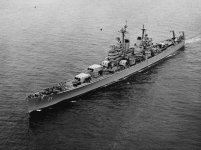Gamecock Fanatics
You are using an out of date browser. It may not display this or other websites correctly.
You should upgrade or use an alternative browser.
You should upgrade or use an alternative browser.
Countdown to Kickoff
- Thread starter Swayin
- Start date
Last edited by a moderator:
USS Kitkun Bay, CVE-71.

The carrier suffered only minor damage during the infamous Battle off Samar while screening Taffy 3, but was hit by a Kamikaze on the port side amidships at the waterline on January 7, 1945. Both the planes 550-lb bombs penetrated the ship but failed to explode.

The carrier suffered only minor damage during the infamous Battle off Samar while screening Taffy 3, but was hit by a Kamikaze on the port side amidships at the waterline on January 7, 1945. Both the planes 550-lb bombs penetrated the ship but failed to explode.
https://en.wikipedia.org/wiki/USS_Kitkun_BayLookouts sighted enemy planes circling about three miles off the ship's port bow at about 6,000 feet at 18:48 on 7 January 1945, near 16°N, 119°10'E. The rumble of antiaircraft fire from the cruisers and destroyers increased in crescendo; however, in a few minutes two Japanese Nakajima Ki-43 Hayabusa Army Type 1 fighter planes detached from their formation and flew toward the carriers. One of the Oscars turned at 18:57 and dived on Kitkun Bay from a relative bearing of 330°.
All available guns including Montpelier (CL-57) and Phoenix (CL-46) opened up on the Oscar and shot off parts of the plane, but the pilot continued his dive through what the ship's historian described as "murderous fire," levelled off close to the water at 3,000 yards, and crashed the suicide plane through Kitkun Bay's port side at the waterline amidships. An explosion and large fire flared up simultaneously with a hit by a 5-inch round from one of the other ships, which burst close to the carrier's bow below a gun sponson, killing and wounding several men—the attack killed 16 men altogether and wounded another 37. The Oscar tore a hole in the ship's side approximately 20 feet long and nine feet high between frames 113 and 121, extending three feet below the waterline.
Kitkun Bay lost power and began listing to port rapidly as her after engine room, machine shop, and gyro spaces flooded. The list increased to 13° with the trim down by the stern four feet at 19:04. Maintainers shifted planes to the starboard side of the flight deck to help correct the list. Firefighters valiantly battled the blaze and extinguished the flames by 19:10, but the flooding continued as seawater poured into the ship in spite of the efforts of the engineers and repair party to contain the damage. Rear Adm. Ofstie prudently ordered all secret and confidential publications destroyed to prevent them from falling into enemy hands. The Medical Department tended to the wounded, and then the captain passed the orders to transfer all "unnecessary" crewmen off the ship; wounded first. Destroyers took off 724 men, leaving less than 200 on board—the rescue party supplemented by volunteers. "We stayed upon the flight deck," Lt. Thomlinson reflected, "ready to scramble into the sea, except when we had urgent business below decks. At 19 degrees list there's no comfort on a carrier."
Despite the risk of a fire touching off ammunition and fuel on board Kitkun Bay, fleet ocean tug Chowanac (ATF-100) closed the carrier and secured a tow line to her at 20:42, and they proceeded toward Santiago Island in the vicinity of Lingayen Gulf. The engineers got steam up in the forward engine room and the damage control teams reduced the list to four degrees. Hopewell (DD-681) and Taylor (DD-468) left the formation to guide and escort Shamrock Bay (CVE-84), which operated a distance away, back into the group, and the carrier joined them during the mid watch. Ofstie then transferred his flag to Shamrock Bay.
The ship operated in the vicinity of the task group throughout 10 January, a day punctuated by two air alerts, though the enemy did not attack. Increasingly heavy seas that evening made the battered carrier's seaworthiness doubtful and maneuvering difficult. Capt. Albert Handly, the commanding officer, requested permission to join the first slow convoy to Leyte that passed in the area, and at 22:00 Kitkun Bay received a message to join some tank landing ships of TU 79.14.3 and make for that island.
Kitkun Bay held the course and station by using the magnetic compass while she limped nearly 500 miles to Leyte Gulf during the next several days. On 11 January, Lt. (j.g.) James A. Jones, USNR, of VC-91 crashed in a Wildcat (BuNo 73623) flying from the ship but a plane guard destroyer rescued him.
On 14 January, the ship launched her own CAP, and later sent the fighters on to Tacloban Airfield on Leyte. Sighting Leyte that afternoon, Kitkun Bay entered Surigao Strait at 23:36, and the following morning anchored in Leyte Gulf. Work on the ship progressed despite an enemy air raid on the night of the 18th. Smoke screens mostly obscured the Allied ships anchored in the roadstead, so the Japanese planes bombed some of the searchlights positioned on the beaches that they could spot.
Additional air alerts sent the crew to their battle stations more than once, but they placed a patch over the hole in the side and pumped the water out of the flooded compartments. Men discovered a Japanese 550-pound armor-piercing bomb wedged into the No. 3 boiler on the 20th. The deadly device had torn through Kitkun Bay and stopped there without exploding, but ordnance disposal sailors from Leyte boarded the ship and cut through the boiler to remove the bomb—while all hands stayed clear of the area. The bomb experts discovered a second unexploded 550-pounder in the previously flooded machine shop, and de-armed and jettisoned over the side both bombs, the first one at 23:06 and the second at 15:10 the following day.
Last edited by a moderator:
USS Ross, DDG-71.
.jpg/1920px-USS_Ross_is_underway._(23439135473).jpg)
https://en.wikipedia.org/wiki/USS_Ross_(DDG-71)

https://en.wikipedia.org/wiki/Donald_K._Ross
Nimitz gave him his Medal of Honor the day of Doolittle's Raid.
A career Navy enlisted man who did it right. Sa-lute.
.jpg/1920px-USS_Ross_is_underway._(23439135473).jpg)
https://en.wikipedia.org/wiki/USS_Ross_(DDG-71)
Donald Kirby Ross (December 8, 1910 – May 27, 1992) was an officer of the United States Navy who received the first Medal of Honor of World War II. This award was made for his actions during the Japanese attack on Pearl Harbor in 1941.
Early career
Ross was born on December 8, 1910, in Beverly, Kansas. He enlisted in the U.S. Navy in Denver, Colorado, on June 3, 1929, and graduated as company honorman from basic training at Naval Station San Diego. He completed Machinist Mate School at Norfolk, Virginia, first in his class and was assigned to the transport ship USS Henderson (AP-1) on a China service run.
While serving aboard the hospital ship USS Relief (AH-1), Ross saw his first action (with the U.S. Marines) in Nicaragua in 1931. Advancing through the ranks on the minesweeper USS Brant (AM-24), destroyer USS Simpson (DD-221) and cruiser USS Minneapolis (CA-36), he attained the rank of warrant officer machinist in October 1940, and was assigned to the battleship USS Nevada (BB-36).
World War II and post-war career
During the December 7, 1941, Japanese attack on Pearl Harbor, Nevada was badly damaged by bombs and torpedoes. Ross distinguished himself by assuming responsibility to furnish power to get the ship underway — the only battleship to do so during the Japanese attack. When the forward dynamo room where he was stationed filled with smoke and steam, he ordered his men to leave and continued servicing the dynamo himself until being blinded and falling unconscious. Upon being rescued and resuscitated, he went back to secure the forward dynamo, then worked in the aft dynamo room until losing consciousness a second time due to exhaustion. After waking, he again returned to his duties until Nevada was beached. His actions kept the ship under power, preventing it from sinking in the channel and blocking other ships in the harbor.
Despite his impaired eyesight, Ross refused hospitalization and instead helped with rescue efforts. He entered a hospital three days after the attack, and his vision returned to normal after three weeks. He returned to Nevada, December 17, 1941, remaining in the ship's company for the duration of the war. For these actions, he was presented with the Medal of Honor by Admiral Chester Nimitz on April 18, 1942, becoming the first person to receive the medal in World War II.
Ross was promoted to chief warrant machinist in March 1942 and was commissioned an ensign in June 1942. Later in the war, he also served on Nevada during the landings at Normandy and Southern France.
He rose steadily in temporary rank to lieutenant commander by the end of the war, reverting to lieutenant at its conclusion. He again received promotion to lieutenant commander in 1949 and to commander in November 1954. Upon his retirement from active duty in July 1956, after twenty-seven years' of service aboard every type of surface ship then afloat, he was promoted to captain on the basis of his combat awards.

https://en.wikipedia.org/wiki/Donald_K._Ross
Nimitz gave him his Medal of Honor the day of Doolittle's Raid.
A career Navy enlisted man who did it right. Sa-lute.
Last edited by a moderator:
Speaking of Mike. Hilarious responses to the tweet. MD is gold.
https://catcrave.com/2021/04/23/carolina-panthers-former-rb-mike-davis-hilarious-twitter-response/
https://catcrave.com/2021/04/23/carolina-panthers-former-rb-mike-davis-hilarious-twitter-response/
Homebrewcock
GCF Top Poster

Last edited by a moderator:
Douglas P-70 Nighthawk
https://www.militaryfactory.com/aircraft/imgs/lrg/douglas-p70-nightfighter.jpg
https://www.militaryfactory.com/aircraft/imgs/lrg/douglas-p70-nightfighter.jpg
USS Carl Vinson, CVN-70.
_underway_in_the_Indian_Ocean_prior_to_flight_operations.jpg/1280px-US_Navy_050315-N-3241H-001_The_Nimitz-class_aircraft_carrier_USS_Carl_Vinson_(CVN_70)_underway_in_the_Indian_Ocean_prior_to_flight_operations.jpg)
https://en.wikipedia.org/wiki/USS_Carl_Vinson
I deployed on this flattop in the Desert Storm era. Here's a pic I took during the rush hour commute on the Chucky V.

The ship's Executive Officer, whose name I don't remember, was a USC alum who proudly wore a Gamecock patch on his flight suit.
Fast cars. Fast women. Less Filling. Tastes Great. Good times.
Go Cocks!
_underway_in_the_Indian_Ocean_prior_to_flight_operations.jpg/1280px-US_Navy_050315-N-3241H-001_The_Nimitz-class_aircraft_carrier_USS_Carl_Vinson_(CVN_70)_underway_in_the_Indian_Ocean_prior_to_flight_operations.jpg)
https://en.wikipedia.org/wiki/USS_Carl_Vinson
I deployed on this flattop in the Desert Storm era. Here's a pic I took during the rush hour commute on the Chucky V.
The ship's Executive Officer, whose name I don't remember, was a USC alum who proudly wore a Gamecock patch on his flight suit.
Fast cars. Fast women. Less Filling. Tastes Great. Good times.
Go Cocks!
Last edited by a moderator:


:format(jpeg)/cdn.vox-cdn.com/uploads/chorus_image/image/46629988/GettyImages-187001013.0.jpg)

.jpg)
_(16446321013).jpg/1280px-140923-N-SB299-242_USS_Theodore_Roosevelt_(CVN_71)_(16446321013).jpg)

:format(jpeg)/cdn.vox-cdn.com/uploads/chorus_image/image/49612567/usa-today-8120363.0.jpg)